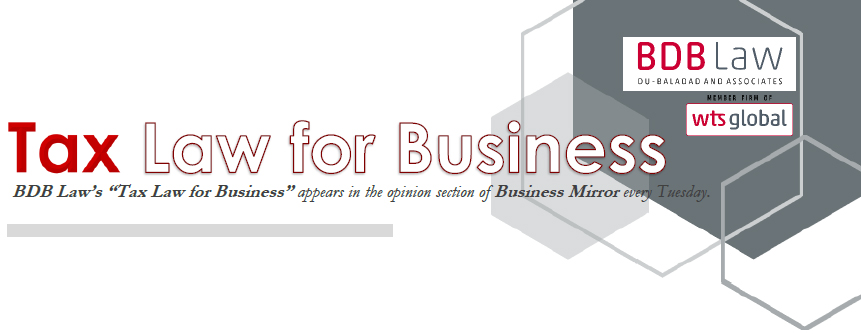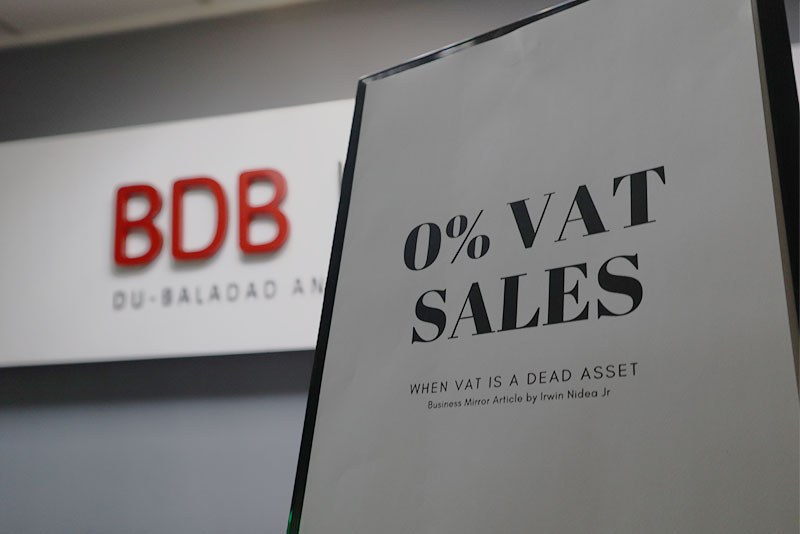
When VAT is a Dead Asset
By Atty. Irwin C. Nidea Jr.
"This landmark decision will have an immense impact on taxpayers that have accumulated a substantial amount of input tax which cannot be used against any output VAT, i.e., companies that are solely engaged in direct export, sale of power and energy, etc. If these taxpayers choose to continuously accumulate their input VAT, they can only recover it upon dissolution. Ironically, it will remain a dead asset until the corporation dies."
Generally, it is only when a taxpayer is engaged in zero-rated sale that the input VAT attributable to such sale may be subject to a refund. This applies to input VAT (purchases) incurred that will be used for direct export, sale to economic zones or sale of power and energy, among others.
The Tax Code states that where the taxpayer is engaged in zero-rated and also in taxable or exempt sale and the amount of creditable input tax due or paid cannot be directly and entirely attributed to any one of the transactions, it shall be allocated proportionately on the basis of the volume of sales.
 It can be argued that this provision allows a taxpayer to claim for refund of input taxes related to VAT zero-rated sales and it does not require a taxpayer to apply all its input taxes, especially its input taxes attributable to zero-rated sales, against its output taxes. In other words, it can be argued that when a taxpayer has output taxes, lesser or higher than the input taxes, all the input taxes related to the zero-rated sales may be the subject of a refund. From the wordings of the law, it may be argued that the only other requirement, aside from having zero-rated sales, is that a taxpayer has input taxes related to that zero-rated sales, and that input taxes related to zero-rated sales had not been applied against output taxes. So, even if the input tax is not sufficient to cover the output tax, the taxpayer can still choose to file a claim for refund of the input VAT that is allocable to zero-rated sales.
It can be argued that this provision allows a taxpayer to claim for refund of input taxes related to VAT zero-rated sales and it does not require a taxpayer to apply all its input taxes, especially its input taxes attributable to zero-rated sales, against its output taxes. In other words, it can be argued that when a taxpayer has output taxes, lesser or higher than the input taxes, all the input taxes related to the zero-rated sales may be the subject of a refund. From the wordings of the law, it may be argued that the only other requirement, aside from having zero-rated sales, is that a taxpayer has input taxes related to that zero-rated sales, and that input taxes related to zero-rated sales had not been applied against output taxes. So, even if the input tax is not sufficient to cover the output tax, the taxpayer can still choose to file a claim for refund of the input VAT that is allocable to zero-rated sales.
The Supreme Court recently struck down this argument. It ruled that input taxes that are subject of a claim for refund are included as part of the input taxes that are available as credit against output taxes. A taxpayer must make all its input taxes, including those related to zero-rated sales, available for credit against output taxes, such that if the input taxes are found to be insufficient all the available input taxes are made to answer for the output taxes.
What if the taxpayer has excess input VAT that was carried over from the previous quarters, can he use it to pay for the output tax of the current quarter?
In the same SC decision, it was ruled that in a claim for refund, if a taxpayer wants to use carried over input VAT to offset with the current quarter’s output tax, he must substantiate all the accumulated input VAT from the previous quarters. It means proving that the accumulated input VAT is supported by valid invoices or official receipts. The invoices and official receipts must comply with the invoicing requirements, i.e., complete name, complete address, tax identification number of the supplier must be shown as well as the proper breakdown of VAT.
This landmark decision will have an immense impact on taxpayers that have accumulated a substantial amount of input tax which cannot be used against any output VAT, i.e., companies that are solely engaged in direct export, sale of power and energy, etc. If these taxpayers choose to continuously accumulate their input VAT, they can only recover it upon dissolution. Ironically, it will remain a dead asset until the corporation dies.
The other alternative is to file a claim for refund every quarter. But it must be noted that the SC ruling has effectively limited the amount that a taxpayer may be entitled to since he cannot use the input VAT from the previous quarters to offset the current quarter’s output VAT, unless it is substantiated. So, if a taxpayer can only substantiate the current quarter’s input VAT, the court will use this to pay for the current quarter’s output tax. What remains, if any, is the amount that will be refunded.
The taxpayer may choose to substantiate the accumulated input VAT so he can utilize it against the current quarter’s output VAT. But this may mean going as far back the beginning of the company’s inception. Remember, what the taxpayer must trace is the accumulation of input VAT which may date back to years ago.
Tax refund is a difficult task. Taxpayers are oftentimes left begging to get back what they own.
The author is a senior partner of Du-Baladad and Associates Law Offices, a member-firm of WTS Global.
The article is for general information only and is not intended, nor should be construed as a substitute for tax, legal or financial advice on any specific matter. Applicability of this article to any actual or particular tax or legal issue should be supported therefore by a professional study or advice. If you have any comments or questions concerning the article, you may e-mail the author at This email address is being protected from spambots. You need JavaScript enabled to view it. or call 8403-2001 local 330.



